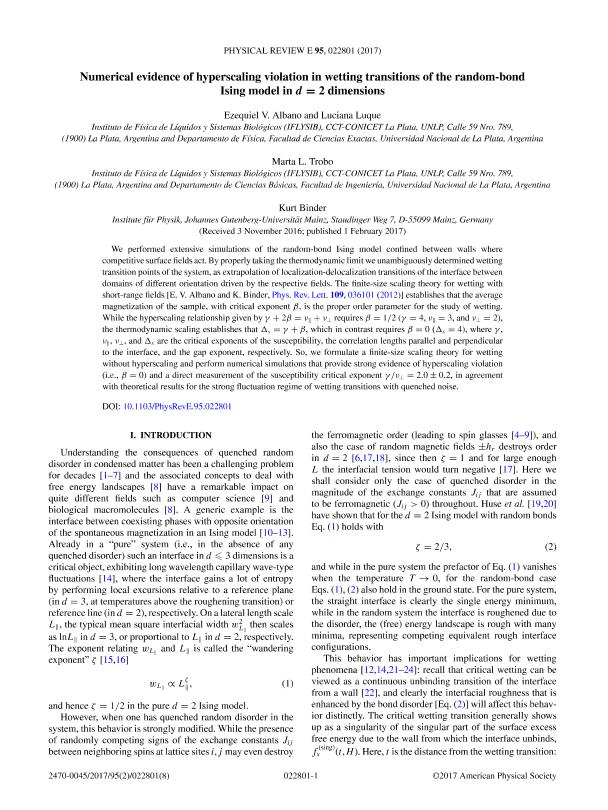Mostrar el registro sencillo del ítem
dc.contributor.author
Albano, Ezequiel Vicente

dc.contributor.author
Luque, Luciana Melina

dc.contributor.author
Trobo, Marta Liliana

dc.contributor.author
Binder, Kurt
dc.date.available
2018-06-11T16:19:24Z
dc.date.issued
2017-02
dc.identifier.citation
Albano, Ezequiel Vicente; Luque, Luciana Melina; Trobo, Marta Liliana; Binder, Kurt; Numerical evidence of hyperscaling violation in wetting transitions of the random-bond Ising model in d = 2 dimensions; American Physical Society; Physical Review E; 95; 2; 2-2017; 1-8
dc.identifier.issn
2470-0053
dc.identifier.uri
http://hdl.handle.net/11336/48074
dc.description.abstract
We performed extensive simulations of the random-bond Ising model confined between walls where competitive surface fields act. By properly taking the thermodynamic limit we unambiguously determined wetting transition points of the system, as extrapolation of localization-delocalization transitions of the interface between domains of different orientation driven by the respective fields. The finite-size scaling theory for wetting with short-range fields [E. V. Albano and K. Binder, Phys. Rev. Lett. 109, 036101 (2012)PRLTAO0031-900710.1103/PhysRevLett.109.036101] establishes that the average magnetization of the sample, with critical exponent β, is the proper order parameter for the study of wetting. While the hyperscaling relationship given by γ+2β=ν +ν requires β=1/2 (γ=4, ν =3, and ν =2), the thermodynamic scaling establishes that Δs=γ+β, which in contrast requires β=0 (Δs=4), where γ, ν, ν, and Δs are the critical exponents of the susceptibility, the correlation lengths parallel and perpendicular to the interface, and the gap exponent, respectively. So, we formulate a finite-size scaling theory for wetting without hyperscaling and perform numerical simulations that provide strong evidence of hyperscaling violation (i.e., β=0) and a direct measurement of the susceptibility critical exponent γ/ν =2.0±0.2, in agreement with theoretical results for the strong fluctuation regime of wetting transitions with quenched noise.
dc.format
application/pdf
dc.language.iso
eng
dc.publisher
American Physical Society
dc.rights
info:eu-repo/semantics/openAccess
dc.rights.uri
https://creativecommons.org/licenses/by-nc-sa/2.5/ar/
dc.subject
Wetting
dc.subject
Transitions
dc.subject
Hyperscaling
dc.subject.classification
Astronomía

dc.subject.classification
Ciencias Físicas

dc.subject.classification
CIENCIAS NATURALES Y EXACTAS

dc.title
Numerical evidence of hyperscaling violation in wetting transitions of the random-bond Ising model in d = 2 dimensions
dc.type
info:eu-repo/semantics/article
dc.type
info:ar-repo/semantics/artículo
dc.type
info:eu-repo/semantics/publishedVersion
dc.date.updated
2018-06-08T14:26:00Z
dc.journal.volume
95
dc.journal.number
2
dc.journal.pagination
1-8
dc.journal.pais
Estados Unidos

dc.journal.ciudad
nueva York
dc.description.fil
Fil: Albano, Ezequiel Vicente. Consejo Nacional de Investigaciones Científicas y Técnicas. Centro Científico Tecnológico Conicet - La Plata. Instituto de Física de Líquidos y Sistemas Biológicos. Universidad Nacional de La Plata. Facultad de Ciencias Exactas. Instituto de Física de Líquidos y Sistemas Biológicos; Argentina
dc.description.fil
Fil: Luque, Luciana Melina. Consejo Nacional de Investigaciones Científicas y Técnicas. Centro Científico Tecnológico Conicet - La Plata. Instituto de Física de Líquidos y Sistemas Biológicos. Universidad Nacional de La Plata. Facultad de Ciencias Exactas. Instituto de Física de Líquidos y Sistemas Biológicos; Argentina
dc.description.fil
Fil: Trobo, Marta Liliana. Consejo Nacional de Investigaciones Científicas y Técnicas. Centro Científico Tecnológico Conicet - La Plata. Instituto de Física de Líquidos y Sistemas Biológicos. Universidad Nacional de La Plata. Facultad de Ciencias Exactas. Instituto de Física de Líquidos y Sistemas Biológicos; Argentina
dc.description.fil
Fil: Binder, Kurt. University Mainz. Institute of Inorganic and Analytical Chemistry, Johannes Gutenberg; Alemania
dc.journal.title
Physical Review E
dc.relation.alternativeid
info:eu-repo/semantics/altIdentifier/doi/https://dx.doi.org/10.1103/PhysRevE.95.022801
dc.relation.alternativeid
info:eu-repo/semantics/altIdentifier/url/https://journals.aps.org/pre/abstract/10.1103/PhysRevE.95.022801#fulltext
Archivos asociados
